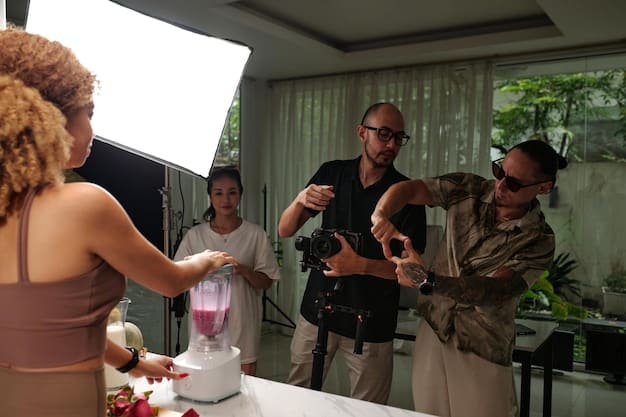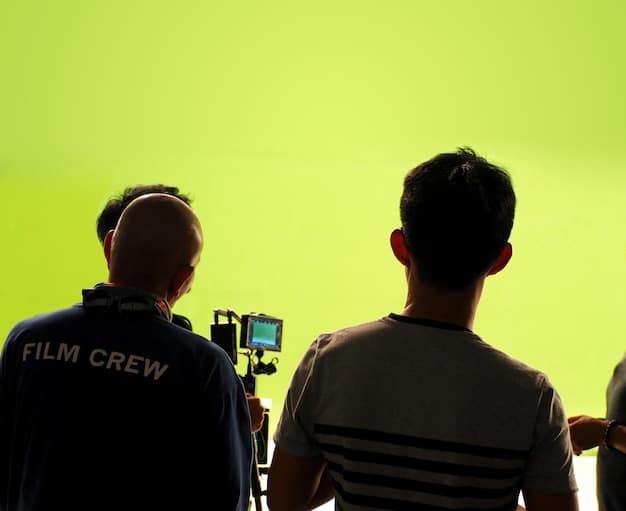Micro-Budget Mastery: 4 Indie Films That Defy the Odds

The art of the micro-budget in filmmaking showcases incredible creativity, proving that compelling stories and innovative techniques can thrive even with limited financial resources, as demonstrated by these four inspiring indie films.
Dive into the world of indie filmmaking and discover how the art of the micro-budget: 4 indie films that prove creativity trumps cash. It’s a testament to vision, passion, and resourcefulness in storytelling.
The Allure of Micro-Budget Filmmaking
Micro-budget filmmaking represents a defiant, innovative corner of the film industry where constraints become catalysts for creativity. It’s where stories are born more from passion than from deep pockets, and where ingenuity steps in to fill the gaps left by limited resources.
These films often resonate deeply with audiences precisely because of their raw authenticity and the visible dedication of the filmmakers. They are a reminder that the heart of cinema lies in storytelling, not just in spectacle.
Why Micro-Budget?
The limitations of a micro-budget force filmmakers to be incredibly resourceful and innovative. This often leads to unique and creative solutions that wouldn’t be considered on a larger production.
The Core Principles
Effective micro-budget filmmaking hinges on a few key principles, including prioritizing story, maximizing available resources, and fostering a collaborative spirit among the cast and crew.
- Story is King: A compelling narrative is paramount.
- Resourcefulness: Utilizing every available resource creatively.
- Collaboration: Building a strong, dedicated team.
- Innovation: Finding creative solutions to budget limitations.

Ultimately, micro-budget filmmaking is about proving that the size of the budget doesn’t dictate the quality of the film. It’s about using constraints as a springboard for creativity, resulting in movies that are often more innovative and emotionally resonant than their big-budget counterparts.
“Primer” (2004): Time Travel on a Shoestring
Shane Carruth’s “Primer” is a mind-bending science fiction film that showcases how complex ideas can be explored effectively on a minimal budget. With a budget of only $7,000, Carruth wrote, directed, produced, edited, and starred in the film.
“Primer” is frequently praised for its intricate plot and its ability to create a compelling narrative around time travel, despite its budgetary limitations. The film’s visual style is understated, which allows the audience to focus on the complex storyline and the characters’ motivations.
Low-Budget Genius
Carruth’s multiple roles in the film were instrumental in keeping costs down. He also relied on non-professional actors and shot in various locations around Dallas to minimize expenses.
The Impact of “Primer”
Despite its complex plot, “Primer” has garnered a cult following and critical acclaim for its smart writing and originality. It proved that a low budget doesn’t have to limit ambition or complexity.
- Original Story: A complex yet compelling narrative.
- Multi-Talented Filmmaker: Carruth’s involvement in multiple roles.
- Cult Following: Gained recognition for its unique approach.
- Budget Innovation: Demonstrated effective low-budget techniques.
“Primer” stands as a testament to what a dedicated, multi-talented filmmaker can achieve with limited resources, turning constraints into creative opportunities.
“El Mariachi” (1992): From Zero to Hero
Robert Rodriguez’s “El Mariachi” is a legendary example of micro-budget filmmaking. Made for just $7,000, it launched Rodriguez’s career and demonstrated the power of a compelling story told with minimal resources.
Rodriguez originally intended “El Mariachi” to be a direct-to-video release for the Spanish-language market. However, its originality and energy caught the attention of Hollywood, leading to a major distribution deal with Columbia Pictures.

The Making of a Legend
Rodriguez funded the film by participating in medical research studies. He utilized friends and family as cast and crew and filmed primarily in his hometown of Ciudad Acuña, Mexico.
“El Mariachi’s” Enduring Influence
“El Mariachi” not only launched Rodriguez’s career but also inspired countless independent filmmakers to pursue their visions, regardless of financial constraints. It proved that a great story, told with passion and ingenuity, could break through the barriers of the traditional film industry.
- Resourceful Funding: Funded through unconventional means.
- Community Support: Relied on friends and family.
- Hollywood Breakthrough: Secured a major distribution deal.
- Inspirational Impact: Inspired a generation of indie filmmakers.
“El Mariachi” remains a powerful example of how a small investment, combined with immense creativity and determination, can lead to significant success and lasting impact.
“Following” (1998): Nolan’s Noir Debut
Christopher Nolan’s “Following” is a neo-noir crime thriller that marked the beginning of his celebrated career. Shot in black and white on a budget of only £6,000, the film showcases Nolan’s remarkable ability to create suspense and intrigue with limited resources.
“Following” tells the story of a young writer who becomes entangled in the criminal underworld of London. Nolan’s use of non-linear storytelling and stark black and white cinematography creates a distinctive and memorable cinematic experience.
Nolan’s Early Genius
To keep costs down, Nolan and his crew shot the film on weekends over the course of a year. They utilized available light and locations and relied on the dedication of the cast and crew to bring the story to life.
The Legacy of “Following”
“Following” established Nolan as a major talent in the film industry and demonstrated his ability to craft intricate and compelling narratives on a minimal budget. Its success paved the way for his future big-budget projects, such as “Memento” and “The Dark Knight” trilogy.
- Non-Linear Storytelling: Unique narrative structure.
- Black and White Cinematography: Created a noir aesthetic.
- Weekend Shoots: Filmed over an extended period to save costs.
- Career Launchpad: Established Nolan’s reputation.
With “Following,” Nolan proved that visionary storytelling and innovative filmmaking techniques can overcome budgetary limitations, crafting a film that remains a standout example of indie cinema.
“Paranormal Activity” (2007): Found Footage Phenomenon
Oren Peli’s “Paranormal Activity” is a found-footage horror film that redefined the genre with its simplicity and effectiveness. Made for just $15,000, the film grossed over $193 million worldwide, becoming one of the most profitable films ever made.
“Paranormal Activity” taps into primal fears using a minimalist approach, focusing on suspense and psychological horror rather than gore. Its success lies in its ability to create a sense of realism and unease, drawing viewers into the unfolding supernatural events.
The Power of Simplicity
The film was shot in Peli’s own home using a consumer-grade camera. The cast consisted of relatively unknown actors, and the special effects were kept to a minimum, relying instead on practical effects and clever editing.
“Paranormal Activity’s” Impact on Horror
“Paranormal Activity” revitalized the found-footage genre and demonstrated the power of word-of-mouth marketing. Its success led to numerous sequels and inspired countless other low-budget horror films. It proved that a simple concept, executed effectively, could resonate with a global audience.
- Found-Footage Style: Created a sense of realism.
- Minimalist Approach: Focused on suspense over gore.
- Commercial Success: One of the most profitable films ever.
- Genre Influence: Revitalized the found-footage horror genre.
“Paranormal Activity” showcases how a small investment in a compelling idea, combined with effective marketing, can lead to unprecedented success.
Lessons From Micro-Budget Successes
Analyzing these four films gives some tangible strategies for aspiring filmmakers looking to make a splash without substantial funding. These strategies emphasize resourcefulness, creativity, and a laser focus on storytelling.
From creative financing to collaborative environments and smart post-production choices, each film provides a blueprint that anyone can follow. Knowing about the budget restrictions and how they managed is important for upcoming filmmakers.
Funding Strategies
Think outside the bank. Crowdfunding, personal savings, grants, and even odd jobs like Rodriguez’s medical research participation can provide the necessary capital.
Post-Production Magic
Smart editing, sound design, and music can elevate a film’s production value significantly. Invest time and effort into these elements, and consider partnering with talented post-production professionals.
- Resourcefulness: Think outside the traditional financing models.
- Collaboration: Work with the dedicated, talented crew who believes in your vision.
- Story Focus: Put the majority of your energy in developing something people will want to see.
By internalizing these elements, upcoming filmmakers boost their probability of success while minimizing production costs and maximizing the potential of their work.
| Key Point | Brief Description |
|---|---|
| 💡 Story First | Prioritize compelling narratives over big budgets. |
| 🤝 Collaboration | Build a passionate and dedicated team. |
| 🎬 Resourcefulness | Maximize available resources creatively. |
| 🌟 Innovation | Find creative solutions to overcome limitations. |
[FAQ]
Frequently Asked Questions
▼
A micro-budget film is generally defined as a film made with a very low budget. Although the exact limit varies, it’s typically under $100,000. These films rely on resourcefulness and creativity.
▼
Funding can come from personal savings, crowdfunding platforms like Kickstarter, grants, or even unconventional methods like participating in paid research studies, as Robert Rodriguez did for “El Mariachi.”
▼
Micro-budget filmmaking offers creative freedom and control. It allows filmmakers to experiment and take risks without the pressure of large financial stakes, fostering innovative approaches to storytelling.
▼
The story is paramount. Since resources are limited, a compelling narrative can captivate the audience and compensate for any technical shortcomings. Focus on creating something original and engaging.
▼
Yes, as demonstrated by “Paranormal Activity,” micro-budget films can achieve tremendous commercial success. Effective marketing and positive word-of-mouth can propel these films to a wide audience.
Conclusion
The art of the micro-budget: 4 indie films that prove creativity trumps cash are shining examples of how limited resources can spark incredible innovation. By prioritizing compelling stories, fostering collaboration, and embracing resourcefulness, filmmakers can overcome financial constraints and create impactful, memorable films that resonate with audiences worldwide.





